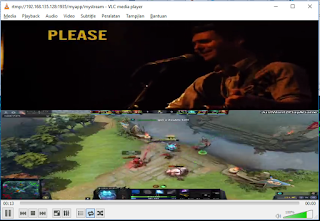Creating Multiple Output with No Filter
Creating multiple output without implement filtering can be done by using command
syntax:
ffmpeg -i input1 -i input2 \
-acodec … -vcodec … output1 \
-acodec … -vcodec … output2 \
-acodec … -vcodec … output3
Pic 1. Multiple Outputs
Here is an example to create several different outputs out HD, VGA and QVGA resolution at the same time with one command
syntax:
ffmpeg -i input \
-s 1280x720 -acodec … -vcodec … output1 \
-s 640x480 -acodec … -vcodec … output2 \
-s 320x240 -acodec … -vcodec … output3
Creating Multiple Output with Same Filter to All Output
To implement same filter in multiple output can be done by using -filter_complex with split filter.
Command below to split=3 means split to three streams
syntax:
ffmpeg -i input -filter_complex '[0:v]yadif,split=3[out1][out2][out3]' \
-map '[out1]' -s 1280x720 -acodec … -vcodec … output1 \
-map '[out2]' -s 640x480 -acodec … -vcodec … output2 \
-map '[out3]' -s 320x240 -acodec … -vcodec … output3
Creating Multiple Output with Specific Filter per each Output
To create multiple output with specific filter per each output can be done by using -filter_complex with split filter, but split goes to input directly.
Below syntax to encode video to three different output at the same time, but boxblur will impact to output1, negate will impact to output2 and yadif will impact to output3.
syntax:
ffmpeg -i input -filter_complex \
'[0:v]split=3[in1][in2][in3];[in1]boxblur[out1];\
[in2]negate[out2];[in3]yadif[out3]' \
-map '[out1]' -acodec … -vcodec … output1 \
-map '[out2]' -acodec … -vcodec … output2 \
-map '[out3]' -acodec … -vcodec … output3
Creating Overlay Image and Running Text with Multiple Output
Here is my own experiment to implement Overlay Image and Running Text in Streaming with multiple resolution and multiple output. The main concern when implement this filter is the Overlay Image and Running Text will only display in output1 and dissappear in other output due to wrong placement of filtering. This is become my concern and do some experiment to find solution on how to put carefully of filtering placement.
Syntax:
ffmpeg -i storm_spirit.mp4 -i addies.jpg -filter_complex \
"[1:v]scale=iw/2:ih/2[logo];[0:v][logo]overlay=W-w-5:H-h-5, \
scale=320:-2,drawbox=x=0:y=122:color=yellow@0.4:width=iw:height=30:t=max, \
drawtext=fontfile=/usr/share/fonts/truetype/freefont/FreeSans.ttf:text='This Is Running Text':\
fontcolor=white@1.0:fontsize=16:y=h-line_h-30:x=w/10*mod(t\,10):\
enable=gt(mod(t\,20)\,10),split=3[a][b][c]" \
-map "[a]" -map 0:a -vcodec libx264 -acodec aac -strict -2 -b:v 256k -b:a 32k -f flv rtmp://192.168.135.128:1935/myapp/mystream \
-map "[b]" -map 0:a -vcodec libx264 -acodec aac -strict -2 -b:v 128k -b:a 32k -f flv rtmp://192.168.135.128:1935/myapp/mystream2 \
-map "[c]" -map 0:a -vcodec libx264 -acodec aac -strict -2 -b:v 96k -b:a 32k -f flv rtmp://192.168.135.128:1935/myapp/mystream3
Pic 2. Overlay Image and Running Text can be implemented in each stream output
Thank youOther Topics:
How to build NGINX RTMP module, Setup Live Streaming with NGINX RTMP module, Publishing Stream with Open Broadcaster Software (OBS), Create Adaptive Streaming with NGINX RTMP, Implementing Filtergraph in Streaming with NGINX RTMP, How to Implement Running Text in Streaming with NGINX RTMP, How to build OpenSceneGraph with Code::Blocks, How to build OpenSceneGraph with Visual Studio 2010, Building Geometry Model, How to run OpenSceneGraph with Netbean IDE 8.2 C++, Rendering Basic Shapes, Using OSG Node to Load 3D Object Model, Rendering 3D Simulator with OpenSceneGraph, How to compile wxWidgets with Visual Studio 2010









